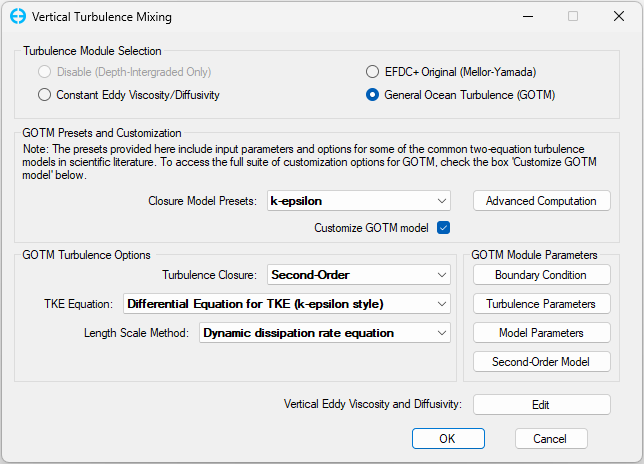...
One of the primary strengths of the General Ocean Turbulence Model (GOTM) lies in its extensive collection of well-tested turbulence models integrated within the code to facilitate the calculation of vertical turbulent fluxes. Its fashion contains a range of approaches, spanning from algebraic equations employed to compute turbulence kinetic energy (TKE) and turbulence length-scale to the utilization of two-equation models, in which both mentioned terms are computed from differential transport equations. The second-order model is an essential part of GOTM, with a full or approximate solution of the transport equations for the turbulent momentum fluxes. As an independent module, the turbulence module in GOTM has been integrated into several three-dimensional hydrodynamic models, including the General Estuarine Transport Model (GETM, Burchard and Bolding (2002)), the Regional Ocean Modelling System (ROMS, Haidvogel et al. (2000)), the Nucleus for European Modelling of the Ocean (NEMO, Madec et al. (1991)), the Finite Volume Community Ocean Model (FVCOM, Chen et al. (2003)).
For further information regarding the GOTM, readers should refer to the official GOTM website (https://www.gotm.net). The website provides access to the source code, comprehensive documentation, and various test scenarios, allowing for more detailed model exploration.
...
The second method is more advanced and allows users to customize the turbulence model following the presetting base. By checking the box Customize GOTM model, the full suite of GOTM turbulence options will be displayed and are able to edit. The Turbulence Closure option includes
includes First-Order and Second-Order. The First-Order method corresponds to models computing the diffusivities from the TKE and the turbulent length scale. TKE and length scale are computed from dynamic PDEs or algebraic relations. The Second-Order method is set by default, corresponds to a second - order model for the turbulent fluxes. The second-order models fall into different categories. As an essential part of GOTM, these models are discussed in detail in (GOTM document https://gotm.net/manual/stable/pdf/a4.pdf).
The TKE equation option specifies the appropriate routines for calculating the turbulent kinetic energy. The user has the choice between:
...
- Algebraic length scale equation (e.g., parabolic, triangular, etc.)
- Dynamic dissipation rate equation
- Dynamic Mellor-Yamada q2l equation
- Generic length scale (GLS)
...
Figure 2: GOTM Turbulence Options
...

